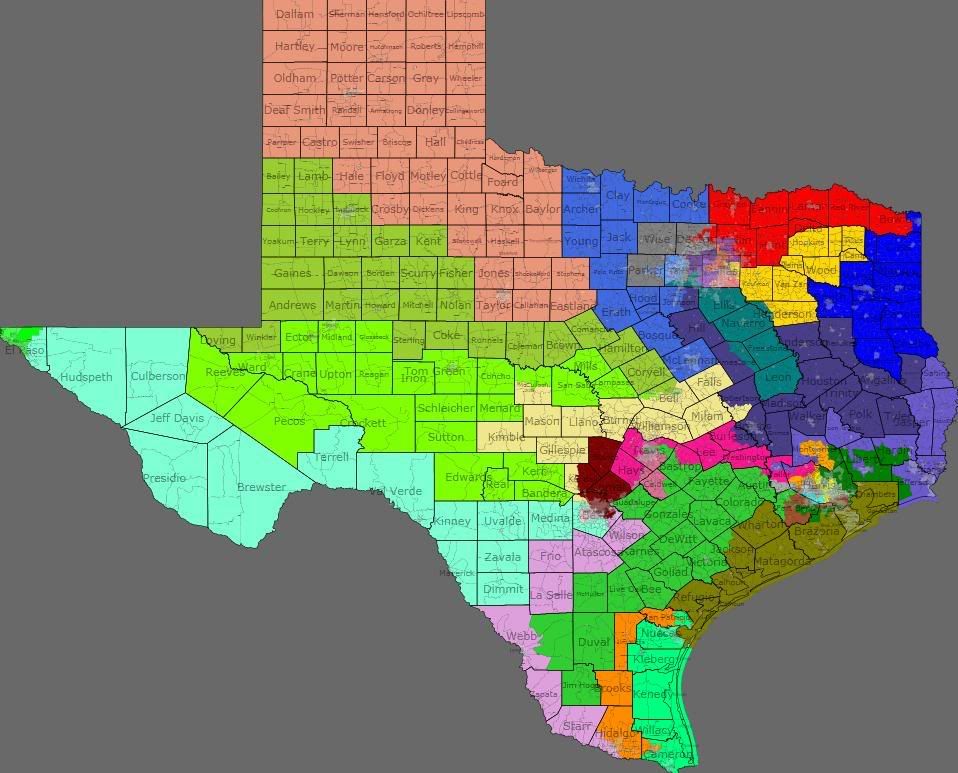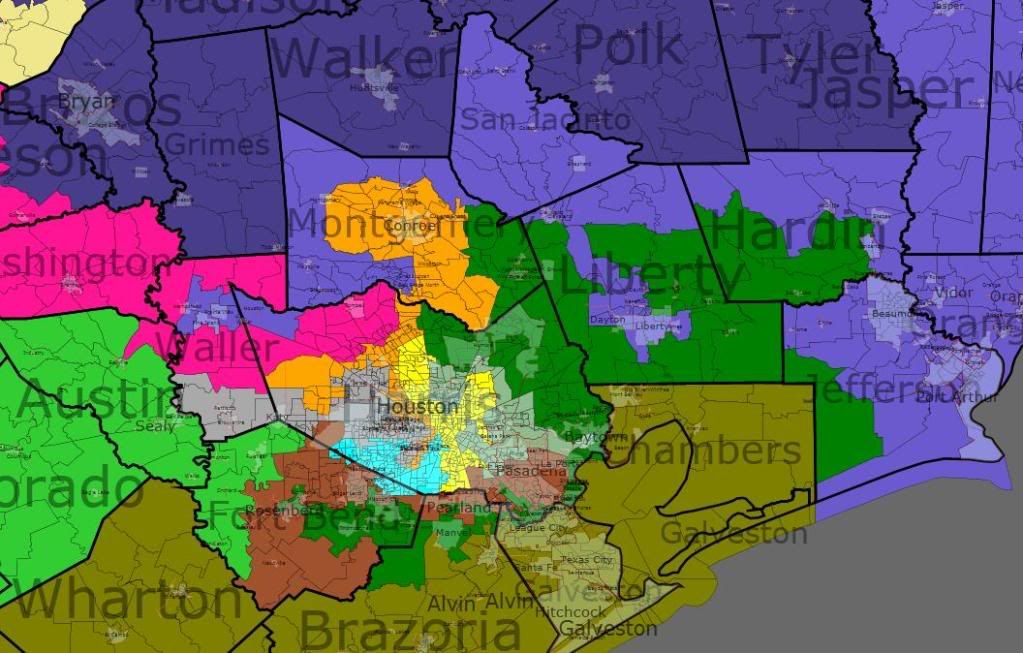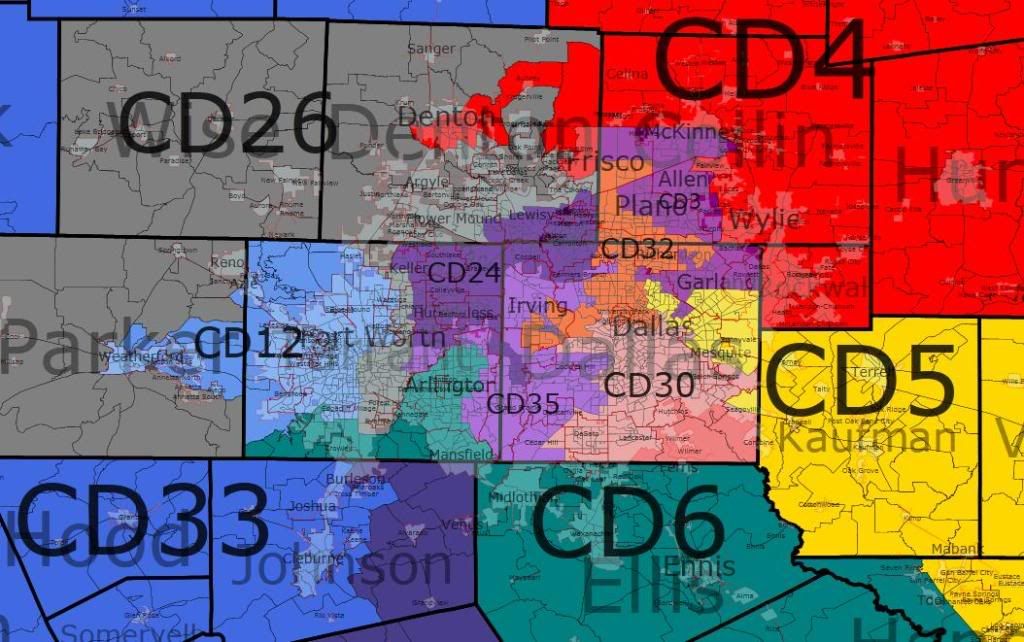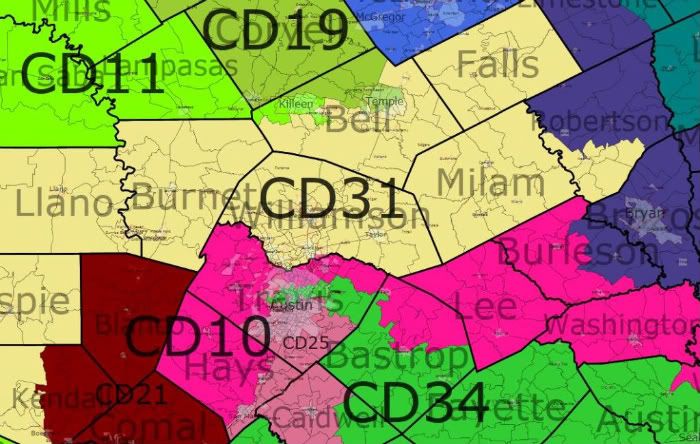I had been working on Texas maps for a few months but wasn’t fully sure about how my districts would turn out without political data. Now that Dave’s Redistricting App has political data for Texas, I have created a 36 seat map that should produce a 25-11 GOP majority. All current incumbents remain safe for the near future, with the exception of Chet Edwards, whose seat is completely dismantled. Four new seats are created, one for the Dems, and three for the GOP. It was interesting to see what’s possible, though I definitely wouldn’t support this plan in real life. Here are some maps as well as my analysis of each district:
Whole State

The Districts
East Texas
District 1 (Blue): East Texas-Tyler, Longview, Texarkana; Louie Gohmert (R)
New 2008 results: 68% McCain-32% Obama
Old 2008 results: 69% McCain-31% Obama
Racial stats: 70% white, 20% black, 8% Hispanic
This is still a solidly-Republican district in East Texas, although the district moves north slightly. Louie Gohmert or any Republican will be more than safe here.
Houston

District 2 (Dark Green): Montgomery County, Humble, Northern Harris County, Fort Bend County; Ted Poe (R)
New 2008 results: 61% McCain-38% Obama
Old 2008 results: 60% McCain-40% Obama
Racial stats: 66% white, 18% Hispanic, 11% black, 5% Asian
This district loses nearly all of its territory in East Texas, including Democratic areas in Liberty, Port Arthur, and Beaumont. It now reaches into Montgomery County. It also stretches down into Brazoria and Fort Bend Counties, as well as Pasadena to help shore up Pete Olson. Still a safe GOP district, and the Republican performance in fact increases.
District 7 (Gray): Houston and western Harris County, Katy; John Culberson (R)
New 2008 results: 62% McCain-37% Obama
Old 2008 results: 58% McCain-41% Obama
Racial stats: 65% white, 20% Hispanic, 9% Asian, 6% black
This district remains, at its core, a heavily Republican district, and in fact becomes more Republican, although the demographics are shifting. Culberson will probably not be in much danger anytime soon seeing as he faced a decent opponent in 2008 and still did very well. The district had to lose some of its Republican areas in the northern half to help create TX-36, a new Republican district, but gains areas to the west from TX-10
District 8 (Light Blueish Purple): Montgomery County, East Texas; Kevin Brady (R)
New 2008 results: 63% McCain-36% Obama
Old 2008 results: 74% McCain-26% Obama
Racial stats: 71% white, 19% black, 8% Hispanic
This district sees a huge drop in Republican performance to help shore up some neighboring districts, but it should not put the GOP in any electoral danger anytime soon. It loses territory in Montgomery County to TX-02 and the new Republican TX-36 and picks up the Democratic areas of Liberty, Beaumont, and Port Arthur from TX-02. Maybe with the diminished influence of Montgomery County Jim Turner or Nick Lampson could have won here in 2004.
District 9 (Light Blue): Southern Harris County; Al Green (D)
New 2008 results: 74% Obama-25% McCain
Old 2008 results: 77% Obama-23% McCain
Racial stats: 34% black, 32% Hispanic, 21% white, 13% Asian
This district keeps a black plurality and remains safely Democratic, so Al Green should be happy and protected from a primary challenge by a Hispanic for the time being. The district became 3 points less Democratic for contiguity reasons, but changed very little.
District 14 (Bronze): Galveston, Brazoria County, Texas coastline; Ron Paul (R)
New 2008 results: 64% McCain-35% Obama
Old 2008 results: 66% McCain-33% Obama
Racial stats: 63% white, 22% Hispanic, 12% black
This district loses its share of Fort Bend County as well as all of Victoria County, but it gains all of Galveston County from TX-22 and some areas from TX-15 and TX-27. Republican performance decreases somewhat, but Ron Paul or any Republican should still be safe here for a long time.
District 18 (Banana Yellow): Houston; Sheila Jackson-Lee (D)
New 2008 results: 83% Obama-17% McCain
Old 2008 results: 77% Obama-22% McCain
Racial stats: 49% black, 31% Hispanic, 15% white
This is now the most Democratic district in Texas and also the most partisan for either party, with a whopping 66% margin for Obama. The black percentage rises to 49%, which will probably isolate Sheila Jackson-Lee from a Hispanic primary challenge, although Al Green may push for some of those black voters for his own district. The Republican and competitive areas on the western edge of the district are lost to the new TX-36, and in return the district picks up some more territory to the south from TX-09.
District 22 (Brown): Sugar Land, Pearland, Pasadena, Rosenberg; Pete Olson (R)
New 2008 results: 61% McCain-38% Obama
Old 2008 results: 58% McCain-41% Obama
Racial stats: 62% white, 19% Hispanic, 11% Asian, 8% black
This already Republican district becomes even more GOP-friendly, and the district shrinks, losing Democratic areas in Fort Bend and Brazoria Counties to TX-02 and all of its territory in Galveston County to TX-14. Pete Olson should be more than okay for now, although the demographics in the district may shift over the next decade. He would probably have performed better against Lampson in 2008 in this district as it lacks now lacks any of Galveston County.
District 29 (Light Grayish Olive): Houston; Gene Green (D)
New 2008 results: 63% Obama-37% McCain
Old 2008 results: 62% Obama-38% McCain
Racial stats: 66% Hispanic, 22% white, 10% black
This district is essentially unchanged from its current form as a Democratic and Hispanic-majority East Houston district, so the only thing Gene Green has to worry about is a Hispanic primary challenger, although that hasn’t been a losing issue for him yet over the last 18 years.
District 36 (Mango): Houston, Conroe, Montgomery County; new Republican district
New 2008 results: 62% McCain-37% Obama
Old 2008 results: New district
Racial stats: 65% white, 23% Hispanic, 7% black, 5% Asian
I thought there was still room in the Houston area to create a new Republican district without really weakening any Republican incumbents and it was indeed possible to so. The district takes all the Republican western parts of Sheila Jackson-Lee’s district and also takes a bit from Culberson, Poe, and McCaul’s districts, although it doesn’t put any of them in serious danger electorally. It also gets a big GOP boost by taking a lot of of Montgomery County from TX-08, which pushes it over the 60% mark. If the Republicans can’t win this new seat it would be shocking.
Dallas/Forth Worth Area

District 3 (Grapy Purple): Plano, Garland; Sam Johnson (R)
New 2008 results: 57 % McCain-42% Obama
Old 2008 results: 57% McCain-42% Obama
Racial stats: 66% white, 16% Hispanic, 9% black, 9% Asian
This district’s 2008 results remain the same, but the district itself changes. The district moves north and east to take in some Collin County areas from TX-04 and loses some Republican areas in Plano to make TX-32 safer. This district should remain in GOP hands for the immediate future, even after Sam Johnson retires.
District 4 (Red): North Texas border counties, Fort Worth suburbs, Denton, Collin County; Ralph Hall (R)
New 2008 results: 67% McCain-32% Obama
Old 2008 results: 69% McCain-30% Obama
Racial stats: 80% white, 10% Hispanic, 7% black
This district becomes a bit less Republican, losing some of its East Texas counties to TX-01 and TX-05 and some of its Collin County territory. It also picks up Democratic areas in Denton to strengthen TX-26. It’s more than safe for Hall or any Republican, although it’s quite different from the East Texas-based district that Hall was elected from earlier in his career.
District 5 (Yellow): Northeast Dallas, rural East Texas counties; Jeb Hensarling (R)
New 2008 results: 63% McCain-36% Obama
Old 2008 results: 63% McCain-36 Obama
Racial stats: 72% white, 14% Hispanic, 12 % black
This district changes geographically but the political realities remain mostly the same, with the district losing some Democratic areas to TX-30 and the rural East Texas part of the district moving north somewhat. Still a safe GOP seat for a while to come.
District 6 (Dark Teal): Arlington, Forth Worth suburbs, Ennis; Joe Barton (R)
New 2008 results: 62% McCain-37% Obama
Old 2008 results: 60% McCain-40% Obama
70% white, 14% Hispanic, 11% white
The district remains essentially in its present form, although it loses some of the southern parts of the district to TX-17. The district becomes more Republican as it loses some Democratic areas in Tarrant County.
District 12 (Periwinkle): Forth Worth, Weatherford; Kay Granger (R)
New 2008 results: 60% McCain-39% Obama
Old 2008 results: 63% McCain-36% Obama
Racial stats: 64% white, 25% Hispanic, 6% black
This district becomes smaller in area as it loses Wise County and much of Parker County to TX-26, but it remains quite Republican. That combined with Kay Granger’s popularity in Forth Worth should keep it red.
District 24 (Dark Purple): Lewisville, Irving, Carollton, Hurst; Kenny Marchant (R)
New 2008 results: 62% McCain-37% Obama
Old 2008 results: 55% McCain-44% Obama
Racial stats: 71% white, 15% Hispanic, 8% Asian, 6% black
While this district may be trending Democratic in the long-term, the southern parts of the district that were more Democratic such as Grand Prairie and Duncanville are now in the new TX-35. The new district is also 71% white, which counters many of the demographic shifts over the past district. The result is a 7% jump in Republican performance, which should keep Kenny Marchant or another Republican safe for the next decade.
District 26 (Dark Gray): Denton suburbs, Fort Worth, Flower Mound, Wise/Parker counties; Michael Burgess (R)
New 2008 results: 62% McCain-38% Obama
Old 2008 results: 58% McCain-41% Obama
Racial stats: 71% white, 14% black, 12% Hispanic
Any improvements that Democrats have made in Fort Worth and Denton County will be cancelled out by this plan. This already Republican district picks up most of the Wise and Parker County areas from TX-12, and the Democratic parts of Denton go to TX-04, which remains quite Republican as well. I didn’t touch the Fort Worth part of the district, which is a remnant of the dismantling of Martin Frost’s old TX-24 and has a lot of Democrats, but it shouldn’t matter too much for now because of Republican strength elsewhere. The district should be a safe GOP hold throughout the decade.
District 30 (Orangish Pink): Dallas; Eddie Bernice Johnson (D)
New 2008 results: 79% Obama-21% McCain
Old 2008 results: 82% Obama-18% McCain
Racial stats: 39% black, 32% Hispanic, 27% white
This remains a heavily Democratic, black-plurality district based in metro Dallas that Eddie Bernice Johnson should be more than happy with. It changes very little although it trades a little territory with TX-05 and TX-32, as well as the new TX-35.
District 32 (Burnt Orange): Dallas, Plano, Richardson, University/Highland Park; Pete Sessions (R)
New 2008 results: 61% McCain-37% Obama
Old 2008 results: 53% McCain-46% Obama
Racial stats: 75% white, 16% Hispanic, 6% black
Perhaps no GOP district swung more to the Democrats than Pete Sessions’ TX-32, which gave John McCain a measly 7% margin of victory in 2008. The district in its current form has only a white plurality, although now it is 74% white. The district becomes more Republican by expanding north into Plano and losing minority areas in Irving and Cockrell Hill to the new TX-35, so Pete Sessions should be safe in his new district, although who knows how demographics will change over the next decade.
District 35 (Grapish Purple): Dallas, Duncanville, Fort Worth, Irving, Cockrell Hill; new Democratic district
New 2008 results: 63% Obama-35% McCain
Old 2008 results: New district
Racial stats: 38% white, 35% Hispanic, 20% black, 6% Asian
In order to make TX-24, TX-26, and TX-32 more safely Republican, I thought it was necessary to draw a new Democratic seat in the Dallas-Fort Worth area. The population growth in the area requires at least one new district around here, and the GOP is stretched pretty thin as it is. So this very-Democratic majority-minority district, which is a bit like Martin Frost’s 2002-2004 district, is created as a result. I think it will probably elect a Hispanic, but I don’t know what the voting-age stats for the district, so maybe Hispanics have less influence than it would seem from the surface. This should be a safe Democratic pickup.
Austin/Central Texas

District 10 (Magenta): Austin/northern Travis County, Hays County, western Harris County; Mike McCaul (R)
New 2008 results: 58% McCain-40% Obama
Old 2008 results: 55% McCain-44% Obama
Racial stats: 74% white, 14% Hispanic, 6% black, 5% Asian
This district has been trending more Democratic and it remains similar to its current form, with a few tweaks to make it more Republican as McCain’s 2008 performance increases by 3 points. It loses some of its Democratic areas in Austin and takes in the more conservative areas of Travis County in the north and west, as well as the conservative western half of Hays County. The eastern half of the district, especially in Harris County, loses its influence somewhat as a result. Also, the Hispanic population is reduced to just 14%. This is now much friendlier turf for Mike McCaul.
District 17 (Dark Blueish Purple): Forth Worth suburbs, Bryan, Huntsville, Lufkin, several rural East Texas counties; Chet Edwards (D) or Republican pickup
New 2008 results: 67% McCain-32% Obama
Old 2008 results: 67% McCain-32% Obama
Racial stats: 69% white, 15% black, 13% Hispanic
Chet Edwards will have a difficult time winning reelection with this map, as he sees his current district dismantled. His base in Waco is put in a new heavily Republican 33rd district along with Wichita Falls and West Texas, while TX-17 retains the more hostile parts of his current district and picks up Republican areas to the east from TX-06, TX-08, and TX-01. I think that Edwards would run in this district as it has more of his current territory, although the East Texas parts of the district would probably be very hostile to him. But Edwards is a fighter and may well survive in this district, just as he has in his current district.
District 25 (Dark Pink): Austin, San Marcos; Lloyd Doggett (D)
New 2008 results: 68% Obama-31% McCain
Old 2008 results: 59% Obama-40% McCain
Racial stats: 51% white, 34% Hispanic, 10% black, 5% Asian
In order to make TX-10 safer for McCaul and create a new Republican TX-34, this district becomes even more of an Austin district and a Democratic stronghold, with Obama’s performance increasing by 9 points to a whopping 68%. The GOP has kind of already ceded this district to Lloyd Doggett, and he will have a much friendlier district.
District 31 (Beige): Temple, Williamson County, Brady, rural West Texas counties
New 2008 results: 61% McCain-37% Obama
Old 2008 results: 58% McCain-42% Obama
Racial stats: 75% white, 16% Hispanic, 6% black
This district becomes more Republican in order to protect John Carter from any possible shifts in Williamson County over the next decade. His district loses Killeen and Temple and some of the northern counties, but gains area in West Texas from TX-11 and TX-21. It should remain easily Republican for the near future.
District 33 (Ocean Blue): Waco, Wichita Falls, North Texas border counties; Chet Edwards (D) or new Republican district
New 2008 results: 71% McCain-29% Obama
Old 2008 results: New district
Racial stats: 77% white, 13% Hispanic, 8% black
This district is heavily Republican and combines parts of West and North Texas from TX-13 such as Wichita Falls, Erath County from TX-31, and parts of Chet Edwards’ 17th district, including his base in Waco. Edwards could run here because it has parts of his old district, most importantly Waco, but it would be an uphill battle given the new territory in North/West Texas. If Edwards doesn’t run here, consider it a safe GOP pickup.
West Texas
District 11 (Lime Green): Midland/Odessa, San Angelo, Killeen; Mike Conaway (R)
New 2008 results: 68% McCain-31% Obama
Old 2008 results: 76% McCain-24% Obama
Racial stats: 57% white, 29% Hispanic, 10% black
While the Republican performance drops 8 points from the current district, it remains extremely Republican. The district loses much of its northern territory to TX-19, and as a result, it shifts east and south to take in territory from TX-21 and TX-23. It also takes in the Democratic areas of Killeen in Bell County, which in turn helps make TX-31 more Republican.
District 13 (Tannish Brown): Amarillo, Abilene; Mac Thornberry (R)
New 2008 results: 77% McCain-22% Obama
Old 2008 results: 77% McCain-23% Obama
Racial stats: 70% white, 23% Hispanic, 5% black
This is still the most Republican district in Texas and one of the most Republican districts in the nation. It changes significantly, losing Wichita Falls and most of the eastern territory to the new TX-33, but picks up Abilene and shifts south into the current TX-19. Interestingly, it is quite possible that if Charlie Stenholm had run in this district in 2004 he could have survived as it has much of his rural base and Abilene. But no other Democrat will win this district for a long time.
District 16 (Bright Green): El Paso; Silvestre Reyes (D)
New 2008 results: 65% Obama-34% McCain
Old 2008 results: 66% Obama-34% McCain
Racial stats: 76% Hispanic, 18% white
This district doesn’t change much at all and remains based in El Paso as a heavily Democratic and Hispanic district. Silvestre Reyes will be in office for as long as he wants.
District 19 (Olive Green): Lubbock, West/Central Texas, Temple; Randy Neugebauer (R)
New 2008 results: 71% McCain, 28% Obama
Old 2008 results: 72% McCain, 27% Obama
Racial stats: 64% white, 26% Hispanic, 8% black
The district loses the city of Abilene and much of its northern territory to TX-13, so it expands eastward to take in parts of TX-31 and picks up Temple and Democratic areas in Bell County. The district becomes only slightly less Republican and Neugebauer and the GOP can consider it a safe hold for years to come.
South Texas
District 15 (Orange): McAllen, Harlingen, Alice; Ruben Hinojosa (D)
New 2008 results: 64% Obama-35% McCain
Old 2008 results: 60% Obama-40% McCain
Racial stats: 84% Hispanic, 15% white
While several of the northwestern counties are lost to the new TX-34 and TX-14, the district remains centered on the border cities of McAllen and Harlingen. It is one of the most Hispanic districts in the country, and Democratic performance increases as well, making victory assured for Hinojosa or any Hispanic Democrat running here.
District 27 (Greenish Turquoise): Corpus Christi, Brownsville; Solomon Ortiz (D)
New 2008 results: 54% McCain-45% Obama
Old 2008 results: 53% McCain-46% Obama
Racial stats: 70% Hispanic, 26% white
This district is virtually unchanged and remains heavily Hispanic and safe for Solomon Ortiz. It only went for Obama by 9 points in 2008 and probably voted for Bush by in 2004, although I don’t think this will become a Republican seat any time soon and I wasn’t going to try at the expense of the new Republican Hill Country district, TX-34.
District 28 (Rose Pink): Laredo, Brownsville; Henry Cuellar (D)
New 2008 results: 63% Obama-36% McCain
Old 2008 results: 56% Obama-44% McCain
Racial stats: 84% Hispanic, 14% white
After losing several eastern Republican counties to the new TX-34, Democratic performance in this district goes up by 7 points, and at 84% it is possibly the most Hispanic district in the country. I wonder if maybe this district could get a better representative than Henry Cuellar now that it is more Democratic…
District 34 (Tropical Green): Austin, Victoria, Texas Hill Country; new Republican district
New 2008 results: 58% McCain-41% Obama
Old 2008 results: New district
Racial stats: 59% white, 30% Hispanic, 8% black
This is one of the most diverse districts in the entire state, containing liberal areas in Austin, conservative areas west of Houston, Victoria and the Central Texas counties known as the Texas Hill Country, and Hispanic areas in South Texas stretching nearly to the Mexican border. It is derived from seven current districts: TX-10, TX-14, TX-15, TX-21, TX-22, TX-25, and TX-28.While the district is just 59% white, it is still very Republican, and would probably elected a Republican easily enough. The demographics may change considerably by the end of the decade though.
San Antonio

District 20 (Peach): San Antonio; Charlie Gonzalez (D)
New 2008 results: 63% Obama, 35% McCain
Old 2008 results: 63% Obama, 36% McCain
Racial stats: 68% Hispanic, 23% white, 6% black
Essentially the same district centered on the city of San Antonio; remains heavily Hispanic and Democratic and becomes even more compact. Not a liability for the Democrats or for Charlie Gonzalez.
District 21 (Reddish Brown): Northern Bexar County/San Antonio, New Braunfels; Lamar Smith (R)
New 2008 results: 61% McCain-38% Obama
Old 2008 results: 58% McCain-41% Obama
Racial stats: 64% white, 24% Hispanic, 8% black
Lamar Smith’s district contracts in area, losing its portions of Travis County and Austin, as well as much of its western parts. It is now almost entirely a Bexar County district, gaining Republican areas from TX-23, which increases the GOP performance by three points, making it an easy hold for the GOP.
District 23 (Sky Blue): El Paso, San Antonio, Eagle Pass; Ciro Rodriguez (D)
New 2008 results: 57% Obama-42% McCain
Old 2008 results: 51% Obama-48% McCain
Racial stats: 68% Hispanic, 26% white
This district goes from swing to heavily Democratic, in large part because of the need for the Republican counties to the north to be taken up by TX-11 and the population growth along the border counties. I think the GOP will concede this one to Rodriguez to avoid weakening TX-21, as well as to make sure that they don’t violate the VRA and have a court redraw the districts again as was the case with the old TX-23 represented by Henry Bonilla from 2004 to 2006. This district was trending Democratic already anyway, now that process is just being accelerated.

Loading ...




